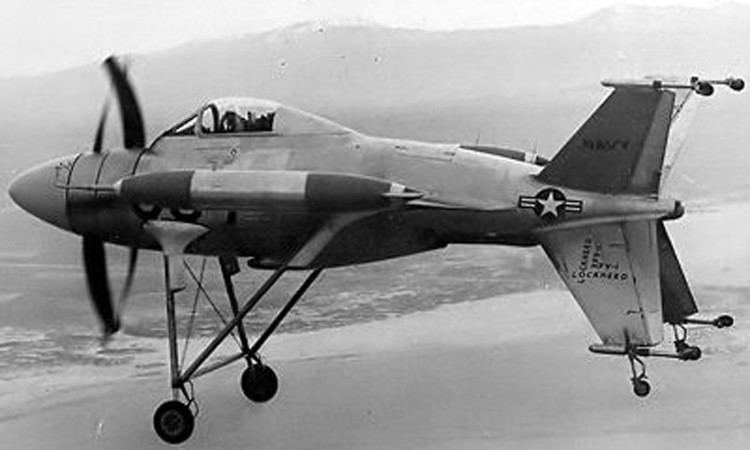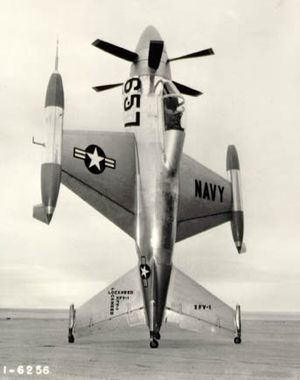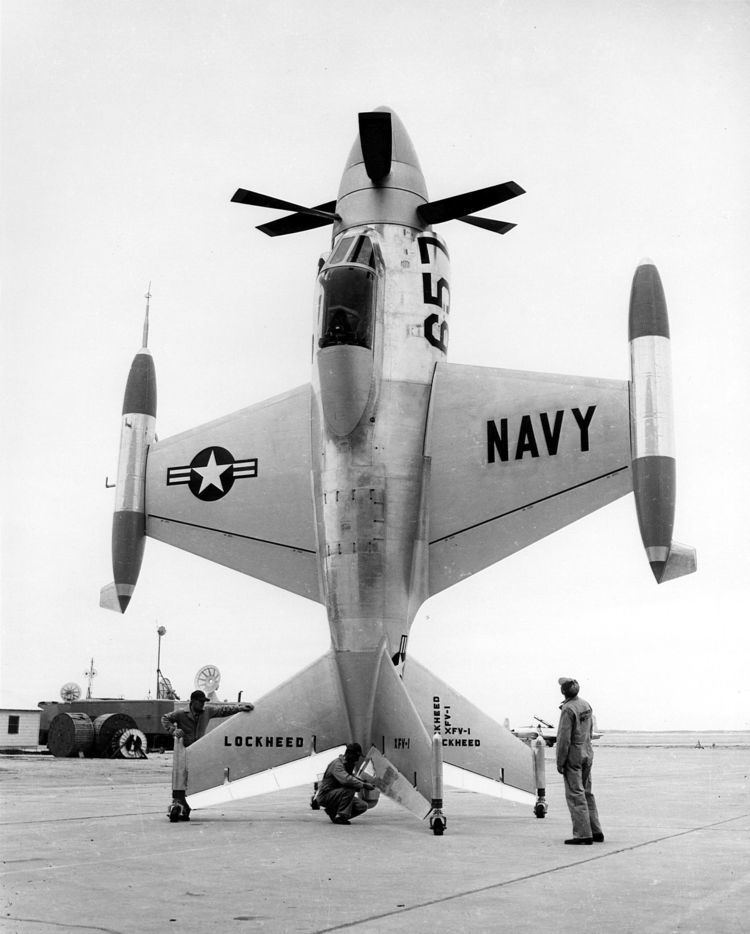Top speed 933 km/h Length 11 m | Wingspan 8.36 m | |
 | ||
The American Lockheed XFV (sometimes referred to as the Salmon) was an experimental tailsitter prototype aircraft built by Lockheed in the early 1950s to demonstrate the operation of a vertical takeoff and landing fighter for protecting convoys.
Contents
- X plane the pogo lockheed xfv 1 new footage
- Design and development
- Testing and evaluation
- Variants proposed
- Aircraft on display
- Specifications
- References

X plane the pogo lockheed xfv 1 new footage
Design and development

The Lockheed XFV originated as a result of a proposal issued by the U.S. Navy in 1948 for an aircraft capable of vertical takeoff and landing (VTOL) aboard platforms mounted on the afterdecks of conventional ships. Both Convair and Lockheed competed for the contract but in 1950, the requirement was revised, with a call for a research aircraft capable of eventually evolving into a VTOL ship-based convoy escort fighter. On 19 April 1951, two prototypes were ordered from Lockheed under the designation XFO-1 (company designation was Model 081-40-01). Soon after the contract was awarded, the project designation changed to XFV-1 when the Navy's code for Lockheed was changed from O to V.

The XFV was powered by a 5,332 hp (3,976 kW) Allison YT40-A-6 turboprop engine driving three-bladed contra-rotating propellers. The tail surfaces were a reflected cruciform v-tail (forming an x) that extended above and below the fuselage. The aircraft had an ungainly appearance on the ground with a makeshift, fixed landing gear attached. Lockheed employees derisively nicknamed the aircraft the "pogo stick" (a direct reference to the rival Convair XFY's name).
Testing and evaluation

To begin flight testing, a temporary non-retractable undercarriage with long braced V-legs was attached to the fuselage, and fixed tail wheels attached to the lower pair of fins. In this form, the aircraft was trucked to Edwards AFB in November 1953 for ground testing and taxiing trials. During one of these tests, at a time when the aft section of the large spinner had not yet been fitted, Lockheed Chief Test Pilot Herman "Fish" Salmon managed to taxi the aircraft past the liftoff speed, and the aircraft made a brief hop on 22 December 1953. The official first flight took place on 16 June 1954.

Full VTOL testing at Edwards AFB was delayed pending the availability of the 7,100 shp Allison YT54, which never materialized. After the brief unintentional hop, the aircraft made a total of 32 flights. All further XFV-1 flights did not involve any vertical takeoffs or landings. The XFV-1 was able to make a few transitions in flight from the conventional to the vertical flight mode and back, and had briefly held in hover at altitude. Performance remained limited by the confines of the flight test regime. With the realization that the XFV's top speeds would be eclipsed by contemporary fighters and that only highly experienced pilots could fly the aircraft, the project was cancelled in June 1955.
Salmon taxied the XFV-1 on its temporary gear "from a standing start to 175 mph, and then brought it back down to a dead stop without any use of the brakes, all within a distance of one mile."
Variants (proposed)
Aircraft on display
The single flying prototype ended up as an exhibit at the Sun 'n Fun Campus Museum at Lakeland Linder Regional Airport in Lakeland, Florida. This example was refurbished at the museum's Buehler Restoration Center and is currently on outdoor display. The aircraft was assigned USN/USMC Bureau Number (BuNo) 138657, but was marked as 658 following restoration. The second prototype, which was never completed, is on display at Los Alamitos Army Airfield in California.
Specifications
General characteristics
Performance
Armament
4 × 20 mm (.79 in) cannons or 48 × 2.75 in (70 mm) rockets
Note: Performance estimates are based on XFV with YT40-A-14 engine.
